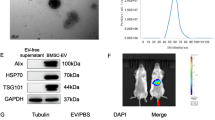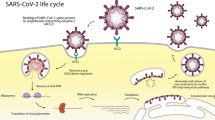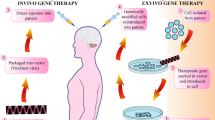Abstract
Background
Previous studies showed that microRNA-29b (miR-29b) inhibits renal fibrosis. Therefore, miR-29b replacement therapy represents a promising approach for treating renal fibrosis. However, an efficient method of kidney-targeted miRNA delivery has yet to be established. Recombinant adeno-associated virus (rAAV) vectors have great potential for clinical application. For kidney-targeted gene delivery, the most suitable AAV serotype has yet to be established. Here, we identified the most suitable AAV serotype for kidney-targeted gene delivery and determined that AAV-mediated miR-29b delivery can suppress renal fibrosis in vivo.
Method
To determine which AAV serotype is suitable for kidney cells, GFP-positive cells were identified by flow cytometry after the infection of rAAV serotype 1–9 vectors containing the EGFP gene. Next, we injected rAAV vectors into the renal pelvis to determine transduction efficiency in vivo. GFP expression was measured seven days after injecting rAAV serotype 1–9 vectors carrying the EGFP gene. Finally, we investigated whether rAAV6-mediated miR-29b delivery can suppress renal fibrosis in UUO mouse model.
Results
We found that rAAV6 vector is the most suitable for targeting kidney cells regardless of animal species in vitro and rAAV6 is the most suitable vector for kidney-targeted in vivo gene delivery in mice. Intra-renal pelvic injection of rAAV vectors can transduce genes into kidney TECs. Furthermore, rAAV6-mediated miR-29b delivery attenuated renal fibrosis in UUO model by suppressing Snail1 expression.
Conclusion
Our study has revealed that rAAV6 is the most suitable serotype for kidney-targeted gene delivery and rAAV6-mediated miR-29b delivery into kidney TECs can suppress established renal fibrosis.






Similar content being viewed by others
References
Liu Y. Cellular and molecular mechanisms of renal fibrosis. Nat Rev Nephrol. 2011;7(12):684–96. https://doi.org/10.1038/nrneph.2011.149.
Grande MT, Sanchez-Laorden B, Lopez-Blau C, De Frutos CA, Boutet A, Arevalo M, et al. Snail1-induced partial epithelial-to-mesenchymal transition drives renal fibrosis in mice and can be targeted to reverse established disease. Nat Med. 2015;21(9):989–97. https://doi.org/10.1038/nm.3901.
Lovisa S, LeBleu VS, Tampe B, Sugimoto H, Vadnagara K, Carstens JL, et al. Epithelial-to-mesenchymal transition induces cell cycle arrest and parenchymal damage in renal fibrosis. Nat Med. 2015;21(9):998–1009. https://doi.org/10.1038/nm.3902.
Zhou D, Liu Y. Renal fibrosis in 2015: Understanding the mechanisms of kidney fibrosis. Nat Rev Nephrol. 2016;12(2):68–70. https://doi.org/10.1038/nrneph.2015.215.
LeBleu VS, Taduri G, O'Connell J, Teng Y, Cooke VG, Woda C, et al. Origin and function of myofibroblasts in kidney fibrosis. Nat Med. 2013;19(8):1047–53. https://doi.org/10.1038/nm.3218.
Borges FT, Melo SA, Ozdemir BC, Kato N, Revuelta I, Miller CA, et al. TGF-beta1-containing exosomes from injured epithelial cells activate fibroblasts to initiate tissue regenerative responses and fibrosis. J Am Soc Nephrol. 2013;24(3):385–92. https://doi.org/10.1681/ASN.2012101031.
Kriegel AJ, Liu Y, Fang Y, Ding X, Liang M. The miR-29 family: genomics, cell biology, and relevance to renal and cardiovascular injury. Physiol Genomics. 2012;44(4):237–44. https://doi.org/10.1152/physiolgenomics.00141.2011.
Qin W, Chung AC, Huang XR, Meng XM, Hui DS, Yu CM, et al. TGF-beta/Smad3 signaling promotes renal fibrosis by inhibiting miR-29. J Am Soc Nephrol. 2011;22(8):1462–74. https://doi.org/10.1681/ASN.2010121308.
Wang B, Komers R, Carew R, Winbanks CE, Xu B, Herman-Edelstein M, et al. Suppression of microRNA-29 expression by TGF-beta1 promotes collagen expression and renal fibrosis. J Am Soc Nephrol. 2012;23(2):252–65. https://doi.org/10.1681/ASN.2011010055.
Chen HY, Zhong X, Huang XR, Meng XM, You Y, Chung AC, et al. MicroRNA-29b inhibits diabetic nephropathy in db/db mice. Mol Ther. 2014;22(4):842–53. https://doi.org/10.1038/mt.2013.235.
Fisher KJ, Jooss K, Alston J, Yang Y, Haecker SE, High K, et al. Recombinant adeno-associated virus for muscle directed gene therapy. Nat Med. 1997;3(3):306–12.
Kessler PD, Podsakoff GM, Chen X, McQuiston SA, Colosi PC, Matelis LA, et al. Gene delivery to skeletal muscle results in sustained expression and systemic delivery of a therapeutic protein. Proc Natl Acad Sci USA. 1996;93(24):14082–7.
Kotterman MA, Schaffer DV. Engineering adeno-associated viruses for clinical gene therapy. Nat Rev Genet. 2014;15(7):445–51. https://doi.org/10.1038/nrg3742.
Smalley E. First AAV gene therapy poised for landmark approval. Nat Biotechnol. 2017;35(11):998–9. https://doi.org/10.1038/nbt1117-998.
Samulski RJ, Muzyczka N. AAV-mediated gene therapy for research and therapeutic purposes. Annu Rev Virol. 2014;1(1):427–51. https://doi.org/10.1146/annurev-virology-031413-085355.
Muramatsu S, Mizukami H, Young NS, Brown KE. Nucleotide sequencing and generation of an infectious clone of adeno-associated virus 3. Virology. 1996;221(1):208–17.
Ito K, Chen J, Khodadadian JJ, Vaughan ED, Lipkowitz M, Poppas DP, et al. Adeno-associated viral vector transduction of green fluorescent protein in kidney: effect of unilateral ureteric obstruction. BJU Int. 2008;101(3):376–81. https://doi.org/10.1111/j.1464-410X.2007.07313.x.
Ru P, Steele R, Newhall P, Phillips NJ, Toth K, Ray RB. miRNA-29b suppresses prostate cancer metastasis by regulating epithelial-mesenchymal transition signaling. Mol Cancer Ther. 2012;11(5):1166–73. https://doi.org/10.1158/1535-7163.MCT-12-0100.
Boden D, Pusch O, Silbermann R, Lee F, Tucker L, Ramratnam B. Enhanced gene silencing of HIV-1 specific siRNA using microRNA designed hairpins. Nucleic Acids Res. 2004;32(3):1154–8. https://doi.org/10.1093/nar/gkh278.
Kida Y, Sato T. Tubular changes in obstructed kidney of adult mice evaluated using immunohistochemistry for segment-specific marker. Histol Histopathol. 2007;22(3):291–303. https://doi.org/10.14670/HH-22.291.
Takeda S, Takahashi M, Mizukami H, Kobayashi E, Takeuchi K, Hakamata Y, et al. Successful gene transfer using adeno-associated virus vectors into the kidney: comparison among adeno-associated virus serotype 1–5 vectors in vitro and in vivo. Nephron Exp Nephrol. 2004;96(4):e119–e12626. https://doi.org/10.1159/000077378.
Rocca CJ, Ur SN, Harrison F, Cherqui S. rAAV9 combined with renal vein injection is optimal for kidney-targeted gene delivery: conclusion of a comparative study. Gene Ther. 2014;21(6):618–28. https://doi.org/10.1038/gt.2014.35.
Zincarelli C, Soltys S, Rengo G, Rabinowitz JE. Analysis of AAV serotypes 1–9 mediated gene expression and tropism in mice after systemic injection. Mol Ther. 2008;16(6):1073–80. https://doi.org/10.1038/mt.2008.76.
Kotterman MA, Schaffer DV. Engineered AAV vectors for improved central nervous system gene delivery. Neurogenesis (Austin). 2015;2(1):e1122700. https://doi.org/10.1080/23262133.2015.1122700.
Thiery JP, Acloque H, Huang RY, Nieto MA. Epithelial-mesenchymal transitions in development and disease. Cell. 2009;139(5):871–90. https://doi.org/10.1016/j.cell.2009.11.007.
Acknowledgements
We thank Dr. Riichi Takahashi and Dr. Motohito Goto of Central Institute for Experimental Animals (CIEA) for supporting our in vivo analysis. This research was supported by a Grants-in-Aid for scientific research (B: 17H04067) and (17K16101) and by the Development program of microRNA measurement technology foundation in body fluid from Japan Agency for Medical Research and development, AMED and supported in part by Strategic Research Foundation Grant-aided Project for Private Universities from the Ministry of Education, Culture, Sports, Science and Technology of Japan.
Author information
Authors and Affiliations
Corresponding author
Additional information
Publisher's Note
Springer Nature remains neutral with regard to jurisdictional claims in published maps and institutional affiliations.
About this article
Cite this article
Saito, S., Ohno, Si., Harada, Y. et al. rAAV6-mediated miR-29b delivery suppresses renal fibrosis. Clin Exp Nephrol 23, 1345–1356 (2019). https://doi.org/10.1007/s10157-019-01783-w
Received:
Accepted:
Published:
Issue Date:
DOI: https://doi.org/10.1007/s10157-019-01783-w




